|
|
|
Sort Order |
|
|
|
Items / Page
|
|
|
|
|
|
|
| Srl | Item |
| 1 |
ID:
121101
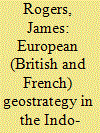

|
|
|
|
|
| Publication |
2013.
|
| Summary/Abstract |
The rise and integration of the Indian Ocean region and the Pacific rim over the past decade - into an 'Indo-Pacific' zone - and the emerging competition between the region's major powers, has drawn increasing attention. However, France and the United Kingdom, while long established in the Indo-Pacific, are often overlooked, even though they are both themselves starting to refocus on the region. Paris has consolidated a 'quadrilateral' of interlocking military stations, which runs down the western Indian Ocean, while London has boosted its 'strategic array', a collection of military facilities, logistical hubs and regional partners and allies, stretching from the Eastern Mediterranean to South-East Asia. Although fiscally under pressure, both countries seem determined to maintain their influence in the Indo-Pacific, but will nonetheless have their work cut out as emerging powers seek to boost their own respective positions in the region. Thus, the two European powers' ability to remain significant actors will depend on their willingness to coordinate with one another and other allies to focus their geopolitical awareness; create new partnerships with the rising Indo-Pacific countries; and provide the necessary resources to maintain - or better, bolster - their naval reach.
|
|
|
|
|
|
|
|
|
|
|
|
|
|
|
|
| 2 |
ID:
121100
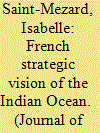

|
|
|
|
|
| Publication |
2013.
|
| Summary/Abstract |
Whether France has an integrated and consistent Indian Ocean strategy or not is open to debate. What is clear though, is that France has some strategic interests in different parts of the Indian Ocean and, on that basis, it has a set of policy priorities. These priorities are threefold: first, to exercise sovereignty over French territories in the south-west Indian Ocean and to maintain an influence in that sub-region; secondly, to deploy a permanent military presence in the Persian Gulf and in the Gulf of Aden, with a capacity to project force in the greater Indian Ocean; and finally, to build a strategic partnership with India, with a view to coordinating maritime security operations in the Indian Ocean Region. The objective of this paper is to look into the kind of challenges that these policy priorities raise for France as well as the policy choices they imply. In so doing, it will suggest that the French ambition to be a power in the Indian Ocean is faced with growing constraints and contradictions.
|
|
|
|
|
|
|
|
|
|
|
|
|
|
|
|
| 3 |
ID:
121098
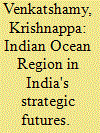

|
|
|
|
|
| Publication |
2013.
|
| Summary/Abstract |
The Indian Ocean has found renewed emphasis in strategic geopolitical discourse and will play an increasing role in global security considerations in the coming decades. From the arc of Islam and Africa on its western reaches to Australia on its east, the vast expanse of the Indian Ocean Region (IOR) and its adjacent waters are considered to be the theatre of conflict and competition in the twenty-first century. The geopolitics of the IOR will have wider implications on the transformations taking place in Asia, the global economy, and key global relationships.
Along with the global economic balance shifting eastward, the US has shed its fixation with the Atlantic has turned its focus to developments in Asia. A paradigm shift from the assumed stability of the world order, propped up at the end of the Cold War, to the change in global power distribution currently underway has thrown Asia, and concomitantly, the IOR into sharp relief. Though geopolitical movements, amidst the rise of China and India, have set the context for viewing the importance of the IOR in a new light, the strategic imperatives of several enduring trends make the region a hotbed of global challenges.
|
|
|
|
|
|
|
|
|
|
|
|
|
|
|
|
| 4 |
ID:
121097
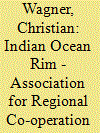

|
|
|
|
|
| Publication |
2013.
|
| Summary/Abstract |
The Indian Ocean has received new attention in recent years because of its economic and strategic importance. The region is seen as a theatre for great power rivalries mainly between the United States, China, and India. In contrast to this, the Indian Ocean Rim - Association for Regional Co-operation (IOR-ARC) has hardly attained any political importance more than 15 years after its inauguration. The economic and political divergences among its 20 members and the competition with (sub-)regional organisations have limited its impact. The futile quest for regionalism should be replaced by a new understanding of the IOR-ARC as an international or inter-regional organisation that deals with different maritime issues. This would pave the way to promote closer cooperation between the different regional organisations and to enter into meaningful collaboration with the international community in order to fight common threats.
|
|
|
|
|
|
|
|
|
|
|
|
|
|
|
|
| 5 |
ID:
121103
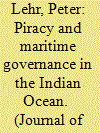

|
|
|
|
|
| Publication |
2013.
|
| Summary/Abstract |
During the late 1990s and the early 2000s, this author conducted a comparative study on regime building in the world's three maritime 'mega regions', i.e., the Atlantic, the (Asia-) Pacific and the Indian Ocean. The aim was to explain why regime building is so difficult in the latter as compared to the former two, and why newly formed regimes tend to end up as 'sandbanks of shattered hope' soon after their inauguration. Many reasons were offered both by the author's numerous respondents and by the author himself, but amongst the findings was the widely shared opinion of specialists from various Indian Ocean Rim countries that attempts at regime building tended to fail because their aims and objectives were too lofty. Rather, it was argued that regime-building attempts should start on the relatively modest level of confidence building measures which all potential participants could agree on, such as disaster relief, search and rescue (SAR), sustainable development of marine resources, fisheries protection, and the fight against piracy. All those measures can be subsumed under the label 'maritime governance', which will be define below.
|
|
|
|
|
|
|
|
|
|
|
|
|
|
|
|
| 6 |
ID:
121099
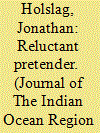

|
|
|
|
|
| Publication |
2013.
|
| Summary/Abstract |
This paper takes stock of China's evolving presence in the Indian Ocean. It posits that despite various traditional and non-traditional threats, the Indian Ocean is not the foremost concern in China's quest for maritime security. As a result, China's efforts to make foray beyond the Strait of Malacca remain limited. Three patterns in its posturing can be distinguished. First, it seeks to deter India - its main counterweight in South Asia - where it is the weakest, that is along the continental border. Second, it explores ways to reduce its reliance on the long maritime lifelines in the Indian Ocean. Third, it is gradually and modestly increasing its presence in a way that can be described as diffuse pervasion. There is thus no reason to be overly alarmed. Yet, important uncertainties remain over China's future intentions and the degree to which problems with lesser powers can prompt it to use military means to defend its interests. Future Chinese naval assertiveness in the region will more likely be the outcome of contingency than strategic provision.
|
|
|
|
|
|
|
|
|
|
|
|
|
|
|
|
| 7 |
ID:
121102


|
|
|
|
|
| Publication |
2013.
|
| Summary/Abstract |
Beginning in late 2011, successive US defence policy documents and official pronouncements explicitly depicted American strategy in Asia in Indo-Pacific terms. Secretary of State Hilary Clinton was the first top US official to frame expanding US partnerships with Australia, India, and Indonesia in the broader Indo-Pacific context. Subsequently, President Barak Obama reaffirmed Clinton's vision in his November 2011 speech to the Australian House of Representatives. Two months later, the Pentagon published its strategic guidance that directed the US military to 'rebalance toward the Asia-Pacific region', declaring that American interests are 'inextricably linked to developments in the arc extending from the western Pacific and East Asia into the Indian Ocean region and South Asia'. The 'pivot' to the Indo-Pacific has since become the driving force behind the US regional strategy.
|
|
|
|
|
|
|
|
|
|
|
|
|
|
|
|
|
|
|
|
|